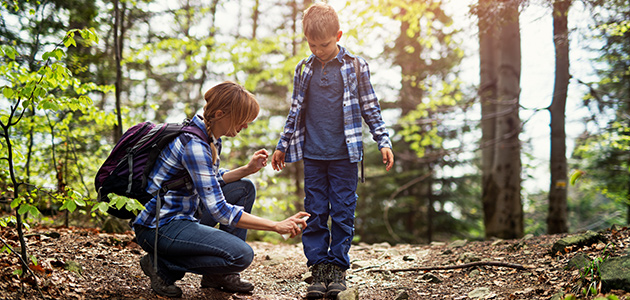
We love the sun, sand, warm breezes and the lazy feel that summer brings – but we all universally hate the bugs that come with it! Unfortunately, we have to share this beautiful season with them – so the best thing we can do is to learn how to prevents bites, and take care of them if we are stung by one of summer’s annoying critters.
Prevention
Obviously not getting stung or bitten is what we’d all prefer, and there are measures you can take to decrease your odds of being bothered by insects.
- Cover exposed skin. This is especially important if you’re hiking in wooded areas or fields with tall grasses. Make sure you wear close fitting pants or leggings, if possible, and wear closed toe shoes, not sandals or flip-flops. Tuck your socks into your pants to keep bugs like ticks from finding their way onto your skin. Wear light-colored clothing so it’s easier to see ticks or other critters that may have attached themselves to your sleeves or pant legs, and wear a hat or bandana to minimize the real estate available on your head.
- Eliminate breeding grounds and attractive bug hideaways. You can’t eliminate all bugs, but you can make your environment less appealing to them. Cover food and drinks if you’re dining outdoors, get rid of any standing water on your property which can turn into breeding grounds for mosquitoes, keep your bushes trimmed and your lawns mowed, and periodically scan for hives and wasp nests on your property (note: these should be removed by professionals).
- Fix your screens. If you have picks or holes in your window screens, replace them or repair them to help keep bugs outside where they belong.
- Use repellant. Insect repellants are important to use and good at doing their job, but if you are concerned about the strong chemicals in commercial insect repellents, you might want to consider making your own using natural ingredients found in recipes like those from Wellness Mama or The Prairie Homestead. If you’re buying a “natural” repellant, you may want to read this article on the effectiveness of certain ingredients.
- Don’t swat. If you find a bee or wasp buzzing in your direction, just calmly move away. Swatting and flailing may annoy them into stinging because it puts them on the defensive.
Treatment
If you do get stung or bitten, make sure to take appropriate measures to treat your bite properly and safely.
Ticks
Ticks are notorious because some species are carriers of Lyme disease, an inflammatory disease that is characterized at first by a rash and/or headache fever and chills, and later by possible arthritis and neurological and cardiac disorders.1 Preventing tick bites is obviously preferable, but if you are bitten, there are important steps to take to remove the tick, and key things to watch for after to ensure you have not contracted Lyme disease. Visit Johns Hopkins Medicine for important information on how to safely remove ticks, and what early symptoms of Lyme disease to watch out for. It’s critical to consult a doctor as soon as possible if you believe you or someone you love has contracted the disease.
Mosquitos
According to Healthline, you should wash a mosquito bite with soap and warm water, then, if you so choose, use over-the-counter antihistamines or a topical anti-itch cream to soothe any pain and itching. If you develop body aches, headache or fever after being bitten by a mosquito, see your doctor to rule out a severe allergic reaction to the bite.
Bees and wasps
If you know you’re allergic to bee or wasp stings, you already know you should seek emergency medical help immediately if you’ve been stung, especially if you’ve had a severe reaction in the past. If you are stung by just one bee or wasp and have no symptoms of an allergic reaction, according to WebMD you can scrape the stinger out with the edge of a credit card or straight object (don’t use tweezers to pull it out as that can inject more venom into your body), clean the area, and ice it to control any swelling. Over-the-counter painkillers and antihistamines can deal with any pain or itching from the site. Keep the area clean to prevent infection.
Symptoms of a severe allergic reaction may include2:
- Trouble breathing or wheezing
- Tightness in the throat or a feeling that the airways are closing
- Hives
- Swelling away from the area of the sting, especially swelling of the face, tongue, or hands
- Hoarseness or trouble speaking
- Nausea, abdominal pain, diarrhea, cramps, or vomiting
- Fast heartbeat or pulse
- Skin that severely itches, tingles, swells, or turns red
- Anxiety, feelings of faintness, or dizziness
- Loss of consciousness
For more information on bee and wasp sting treatment, including a short video, visit WebMD.
We share the summer with all kinds of critters, so learning how to live with them – and how to deal with bites and stings if they happen – is an important step we have to take to fully enjoy the season, and stay as healthy and happy as possible.
SOURCES
1 https://www.google.com/search?q=what+is+lyme+disease&ie=utf-8&oe=utf-8&client=firefox-b
2 https://www.webmd.com/first-aid/allergy-insect-sting-treatment#2
416403A CAN/US (07/18)




